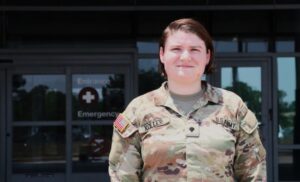
Story by Robert Whetstone
Brooke Army Medical Center Public Affairs
JOINT BASE SAN ANTONIO-FORT SAM HOUSTON, Texas, June 6, 2024 — After work on Feb. 19, U.S. Army Spc. Anne Koller heard voices and went outside of her house to see what was going on. Next, to her surprise, she heard gunfire and saw her neighbor trying to make it back to his home saying he’d been shot.
Koller works at Brooke Army Medical Center in the department of pediatrics. She’s been in the Army for five years and her military occupational specialty is 68W, or combat medic.
According to goarmy.com, combat medics administer emergency medical care in both combat and humanitarian situations. Their training allows them to triage illnesses and injuries to help save lives.
The night she heard voices, she was not in a warzone.
“I heard yelling outside, and I thought my dogs had gotten out,” said Koller. “I went outside and that’s when there were shots fired. I originally thought they (assailants) had shot my dog, but then I saw it was a guy (her neighbor) and he tried to run into his house screaming, ‘I got shot, I got shot,’ and then I took off to make sure he was okay.”
Neighborhood shootings could invoke memories of active shooter incidents in South Texas where numerous innocent children and adults have suffered life ending or life changing outcomes. The Department of Homeland Security teaches those involved in an active shooter event to evacuate the area, or hide and seek cover, and how to react when first responders arrive.
The Federal Emergency Management Agency defines first responders as fire, emergency medical services, law enforcement, emergency management and 911 telecommunications. Although not defined as a first responder, combat medics are trained to react in combat situations and provide emergency medical attention to service members. Koller simply reacted the way she was trained.
That night in February was not an active shooter event; nevertheless, Koller didn’t think about her own safety. She wanted to help her neighbor.
“I had to do improvised occlusive dressings for his gunshot wounds because he had three entry wounds into his chest; he didn’t have any exits (wounds),” she added.
Koller did not have a close relationship with her neighbor, but he would return her dogs whenever they got loose from her property. They would say hello when they saw each other, simply being ‘neighborly.’
Koller, a humble, down-to-earth Soldier who grew up 90 miles north of BAMC in nearby Pflugerville, Texas, had similar impulses when it came to joining the Army. Her family has very little military connection besides two uncles who served.
“My brother and I wanted to join (the Army),” explained Koller. “He and I ended up enlisting a couple of years apart from each other.”
Koller joined the Army to see the world and got stationed a little further south in Texas. She found humor in the irony of this, but perhaps it was fate that she was here at the right moment in time to help her neighbor.
According to the Pew Research Center, less than one percent of U.S. adults join the military. The Army’s mission sounds as simple as it is complex: ‘To fight and win our nation’s wars,’ but it takes special, dedicated Soldiers to accomplish it. Soldiers like Koller – Soldiers who live by a specific creed (https://www.army.mil/values/soldiers.html). It is a creed that is drilled into each Soldier’s memory.
Part of that creed states ‘I am disciplined, physically and mentally tough, trained and proficient in my warrior tasks and drills.’ That winter night in San Antonio, Koller didn’t have time to think, she just followed the instincts of her training – running toward the fight to render emergency medical aid.
Another very important line in the Soldier’s Creed is, ‘I will never leave a fallen comrade.’
“It wasn’t disregard for my own safety,” she said. “I just didn’t think they would try to shoot at me because the windows were rolled up on one side of the car that I was running towards. I just clicked (into training). Someone was hurt and I knew I could help.”
Koller was doing what she was trained to do in combat, but without a Kevlar helmet or body armor, making sure not to leave her fallen comrade.
Despite Koller’s initial lifesaving efforts and those of the emergency medical technicians who arrived on the scene, her neighbor did not survive his fatal wounds.
She said the most important aspect of the incident she would want to pass on to her fellow combat medics is the training. “Honestly it is the repetition (training),” she added. “It was more of like an instinctual response rather than, ‘oh no, I have to think about doing this; oh, I have to think about what can I use for an occlusive dressing.’ It was more like, we don’t have occlusive dressings, let’s use trash bags.”
The constant training became instinctive. And, according to Koller, the training just … clicked.